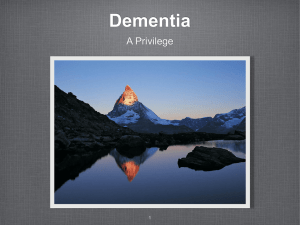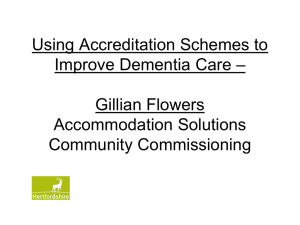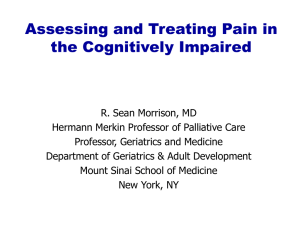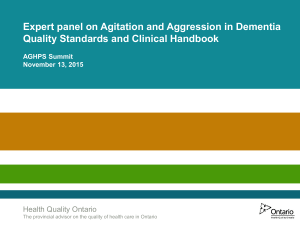Non-pharmacological management of agitation in
advertisement
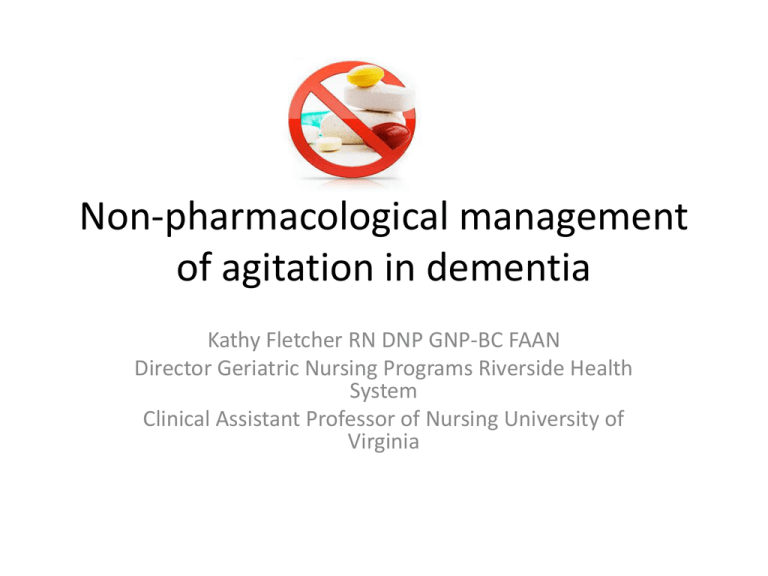
Non-pharmacological management of agitation in dementia Kathy Fletcher RN DNP GNP-BC FAAN Director Geriatric Nursing Programs Riverside Health System Clinical Assistant Professor of Nursing University of Virginia Objectives • Discuss the prevalence of neuropsychiatric symptoms in residents with dementia • Identify the negative outcomes associated with agitation in residents with dementia • Describe the various nonpharmacological therapies used to address agitated behaviors • Review the literature on the effectiveness of non-pharmacological therapies to help manage agitation in residents with dementia Prevalence of Neuropsychiatric Symptoms (NPS)in individuals with dementia • 40% of residents with dementia in special care units and nursing homes have severe to very severe cognitive impairment (Gruneir, 2007) • The majority of residents with severe dementia (50-80%) have one or more NPS—the most common agitation, aggression, psychosis, depression, apathy, withdrawal & aberrant motor behavior (Zuidema, 2007; Kverno, 2008) Negative outcomes of agitation in residents with dementia • Often it is a reason for LTC admission in the first place • Increased use of psychotropic drugs • Diminished quality of life • Resident/family distress • Caregiver burden Best Person-Centered Practice • First determine if the behavior is harmful to the resident or to others • Second: ABC’s: Antecedents, Behavior, Consequences • Third determine if the behavioral or psychological symptoms are the consequence of a physical illness or medications used to treat these • Fourth try non-pharmacological approaches • Last use drugs in the lowest possible dose for the shortest period of time Non-pharmacological therapies Standard therapies: Behavioral Reality orientation Validation Reminiscence Non-pharmacological therapies Alternative /complementary therapies: Art Music Activity Complementary Aroma Bright-light Multisensory approaches Emotion oriented Non-pharmacological therapies Psychotherapies : Cognitive-behavioral Interpersonal Summary • Person-centered and tailored interventions are most appropriate with nonpharmacological approaches • The need to work with professionals, families, and the system to address this concern • Education of the staff to change attitudes and behaviors in intervening with residents demonstrating NPS • More high level research in this area is needed References: • Kverno, KS et al (2009). Research on treating neuropsychiatric symptoms of advanced dementia with nonpharmacological strategies, 1998-2008: a systematic literature review. International Psychogeriatrics, 21 5:825-843. • Douglas, S et al (2004). Nonpharmacological interventions in dementia. Advances in Psychiatric Treatment, 10, 171-179. • Cohen-Mansfield, J et al (2007). Nonpharmacological treatment of agitation: a controlled trial of systematic individualized intervention. Journal of Gerontology, 62A, #8, 908-916. • Kong, EH et al (2009) Nonpharmacological intervention for agitation in dementia: a systematic review and meta-analysis. Aging and mental health, 13, #4, 512-520. • Ayalon, L et al (2006). Effectiveness of nonpharmacological interventions for the management of neuropsychiatric symptoms in patients with dementia: a systematic review. Archives of Internal Medicine, 166, 21822188.



